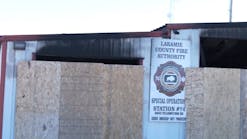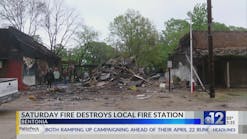Confronting Fire Department Diesel Exhaust Exposure Concerns - Part 2: Taking a Systems Approach
In Part 2 of this six-part series, we will address the importance of a well-considered plan and process for managing firefighter exposures.
As discussed in Part 1, firefighters are exposed to many contaminants throughout their careers. A contaminant of particular concern, because of its complexity and its ubiquitous nature in the environment of firefighters, is diesel exhaust. There are still many uncertainties about the health risks, litigation trends, and available control technologies pertaining to diesel exhaust, and the overall understanding of each of these uncertainties is evolving relatively rapidly. Ultimately, this can make the issue of diesel exhaust seem unpredictable and impossible to manage.
But consider this, firefighters are already among the most noteworthy experts at making the “unpredictable” manageable. To begin to get your arms around this issue, turn to what you know best. A “systems” approach has been widely and successfully used in the fire service since the 1970s. The incident command system (ICS) was originally designed to ensure effective coordination of multiple parties responding to a volatile crisis situation—initially implemented for the wildfires in California in the late 1960s. In 1970, as the California wildfire situation continued to worsen, local, state and federal agencies developed a system of centralized authority that uses a common language and set of expectations. This became known as the ICS. As its successful use became more widespread, the ICS was used for other types of crises and disasters, ultimately being adopted by the Department of Homeland Security as a central feature of the National Incident Management System and the National Response Plan.
Some of the critical basic elements of the ICS, by which firefighters routinely make the “unpredictable” manageable, include the following:
- Leadership commitment to the use of the ICS.
- A hierarchical command structure that clearly identifies levels of accountability, including individual accountabilities.
- Planning, in terms of the use of the system both generally and during response to specific incidents. Includes identification of risk and decision-making relative to the nature and levels of the risks identified.
- Communication and coordination, with a common language and established responsibilities, means and methods.
- Clear procedures and protocols to be followed in each response, but with inherent system flexibility allowing the response to evolve to meet the variable needs of each incident.
- Team competence and training—by position as part of the team.
- The use of forms and checklists to ensure consistency and that the necessary decisions are considered and actions are taken.
- Documentation of each step of the process.
- Post-incident review and critique, including both team and individual performance review.
- Follow-up action by management—post-incident and periodically—to ensure continuous improvement.
Ultimately any safety or health issue is best managed within a similar and familiar “systems” framework, which results in leadership and vision, accountability, consistency and flexibility, while emphasizing continuous improvement. Although a fire or crisis response occurs in a much more compact and unexpected time frame than most kinds of safety and health challenges, a similar system of management can be very effective to address a long-term risk.
Several very useful resources are available on employee safety and health management systems. These resources are not specific to firefighters but provide the structure for a safety management system that applies to firefighters as well as to personnel working in many different industries, just as the ICS is used in a fire incident and it is also used more broadly in response to other scenarios, such as hazardous materials or active shooter incidents.
An effective safety management system must address, but go beyond, Occupational Safety and Health Administration (OSHA) compliance, to ensure more comprehensive protection of firefighters than can be achieved through just complying with the OSHA standards. In the case of diesel exhaust, OSHA provides only limited assistance and OSHA compliance by itself may not ensure firefighter safety or the protection of fire departments from unnecessary and possibly expensive liability.
These systems evolved, as have many other types of management systems, out of the “Plan-Do-Check-Act” (PDCA) Deming Cycle, designed in the 1950s to monitor and improve business performance on a continual basis. For more on the PDCA Cycle, go to the American Society for Quality website.
Safety management systems guidance is available through several well-accepted resources, including:
- The federal Occupational Safety and Health Act and Injury and Illness Prevention Programs White Paper
- The American National Standards Institute (ANSI)—ANSI Z10 (2017)
- The International Labor Organization (ILO) Occupational Safety and Health Management System (OSHMS)
In general, these safety management systems address the same elements that are included in the ICS—leadership, accountability (including individual accountability), planning and communication, clear protocols and procedures, competence and training, consistent documentation, review and critique, and follow-up action to ensure continuous improvement. They also include an important component of employee participation in the process.
A safety management systems approach, applied to concerns about firefighter exposure to diesel exhaust, can be used to ensure a more effective approach to the issue. This can be done by:
- Creating a more solid platform for the department’s efforts to address questions and uncertainties about diesel exhaust—based on clear leadership and accountability, employee participation, and more comprehensive initial research and planning, to address concerns, available risk information, and internal and external resources. This platform should include a plan of action based on the research and planning conducted.
- Driving effective implementation of the plan of action, through clearly-defined responsibilities and accountabilities, as well as appropriate protocols. Examples of protocols to consider might be the correct use of a ventilation system, a procedure for care and cleaning of turnout gear, or a procedure for the annual review of updated information related to diesel exhaust hazards and controls. Of course, effective implementation always requires appropriate methods of training and communication.
- Verifying the effectiveness of the approach through air monitoring, inspections and audits, incident evaluations, and periodic program reviews.
- Ensuring continuous improvement through follow-up action by management, based on the results of the steps taken to verify the effectiveness of the approach. And, of course, documentation of the decisions made and actions taken is vital—from the planning stages through to continuous improvement.
At this point in our discussion, it may seem like we are trying to “make a mountain out of a molehill,” that you don’t have to take such a structured approach to concerns about diesel exhaust. However, a simplified version of this type of systems approach, which is targeted to the issue, can be implemented effectively and without excessive effort. In fact, as was discovered in the 1970s in terms of using the ICS for fire response, a systematic approach is more effective than one that is haphazard, whether the incident is small and simple or much more complex and multi-faceted.
In the remaining four parts of this series on diesel exhaust exposure concerns, we’ll look at how to use this type of framework, along with specific tools and resources that we’ll discuss, to take some of the mystery out of diesel exhaust and to make concerns about diesel exhaust more manageable.
Related Articles:
- Confronting Fire Department Diesel Exhaust Exposure Concerns - Part 1
- Confronting Fire Department Diesel Exhaust Exposure Concerns - Part 2: Taking a Systems Approach
- Confronting Fire Department Diesel Exhaust Exposure Concerns—Part 3: Determining Exposure Sources
- Confronting Fire Department Diesel Exhaust Exposure Concerns - Part 4: Evaluating Exposure Pathways
- Confronting Fire Department Diesel Exhaust Exposure Concerns - Part 5: Maximizing Your Resources
- Confronting Fire Department Diesel Exhaust Exposure Concerns - Part 6: Air Testing & Communication of Exposure Results
- Confronting Turnout Gear, Equipment Contamination in the Fire Station










